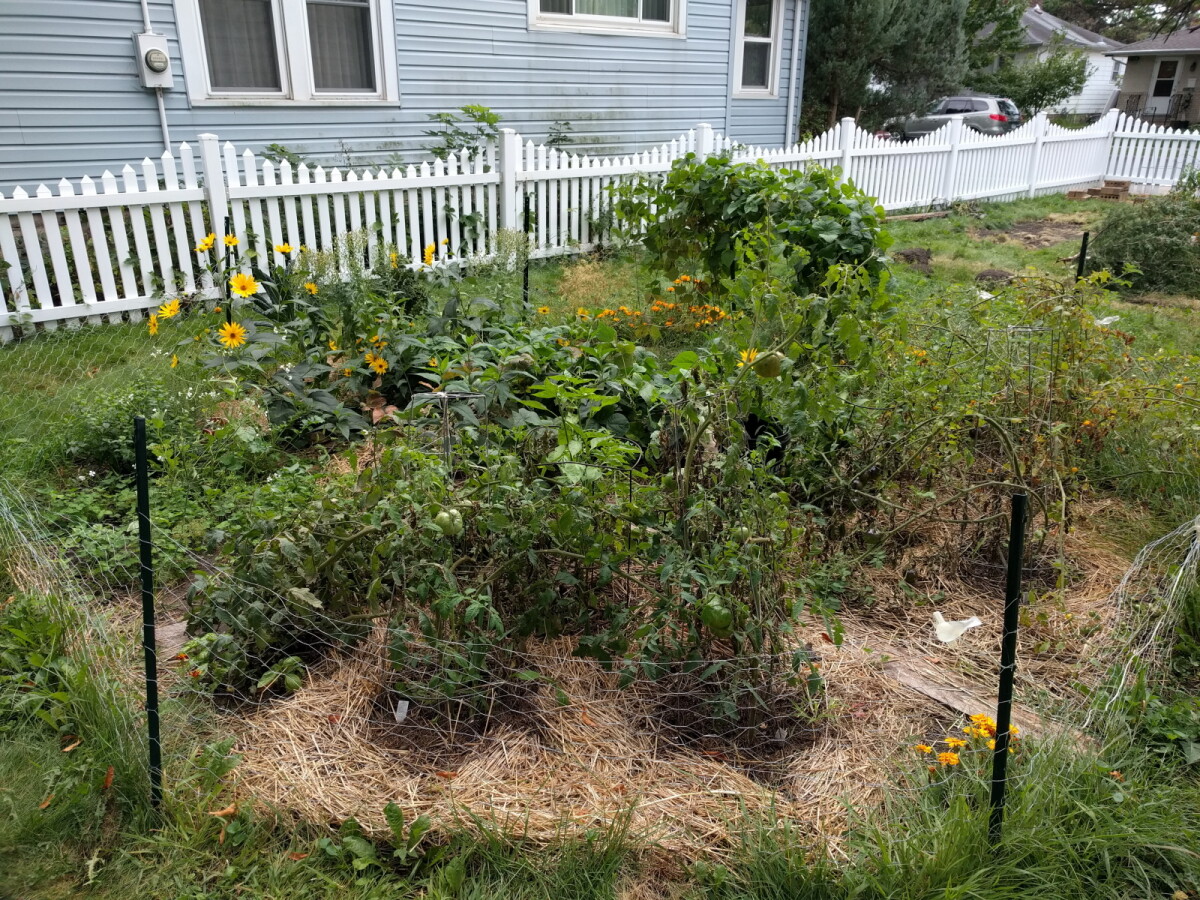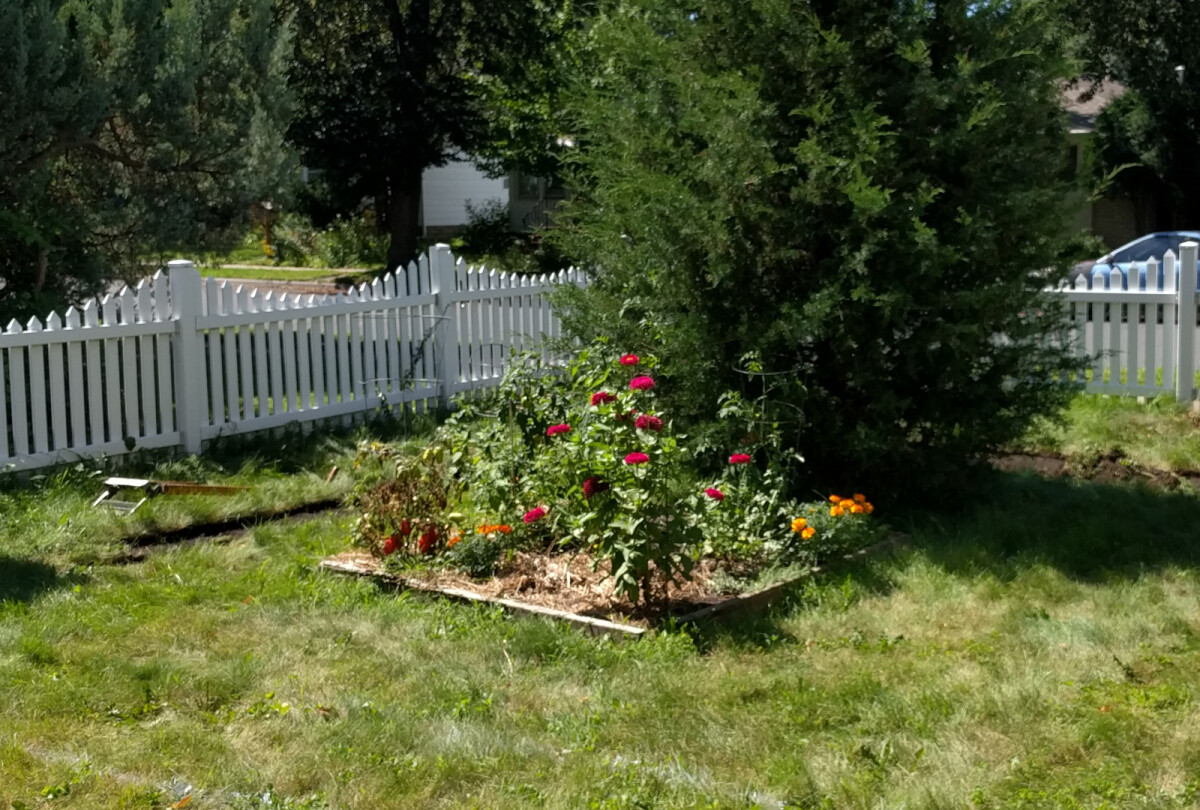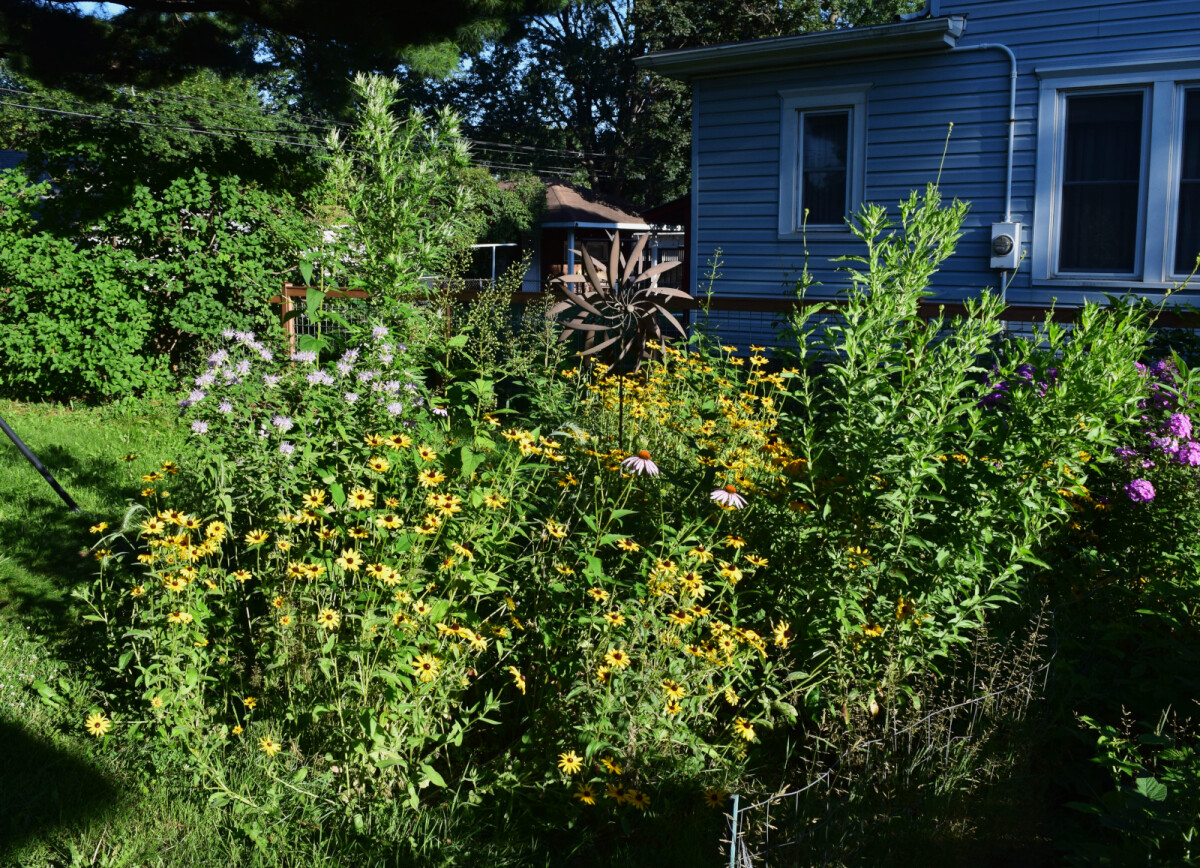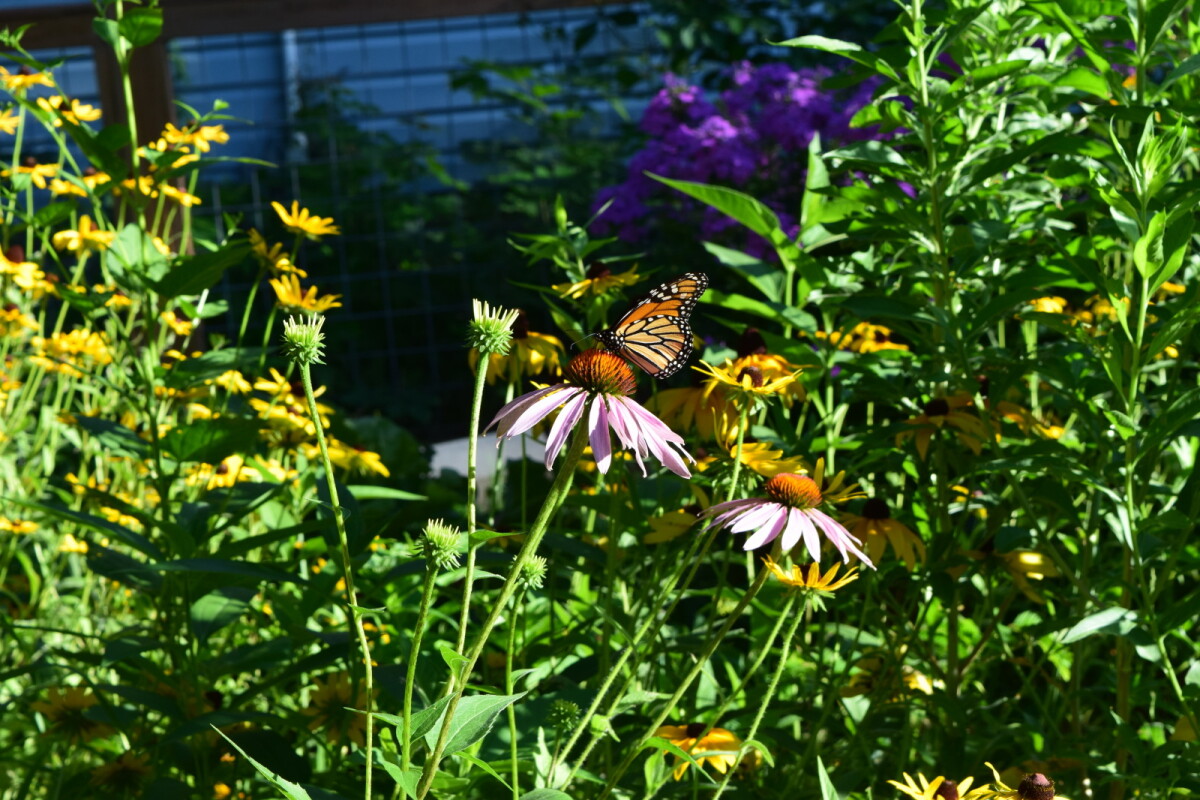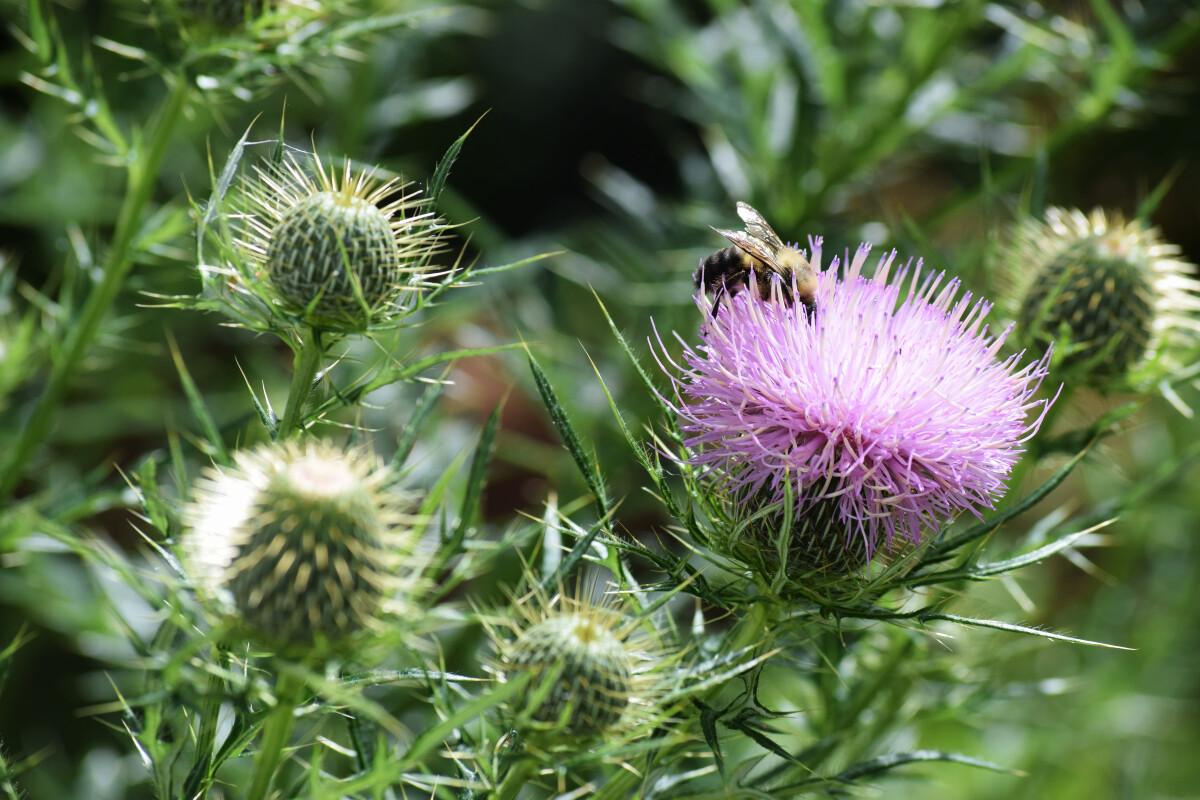I had maintained a small garden at both of the last two places we rented, so now that we had a place of our own I was excited to get a garden going. However, we closed on the house at the end of April, and were consumed with moving and some of the more pressing move-in issues after that. The timeline meant that I wasn’t going to have time to do almost any prep work before planting time rolled around.
In a way, this was a blessing in disguise for me. It forced me to temper my ambitions for the first year, and that gave me a whole growing season to observe and learn about the condition of the land. Thus, when I did start making more permanent decisions I did so well-informed. In the moment, though, it meant I had to get creative about what I could scrap together.
Already present was a small corner near the porch that was absolutely packed with hostas, and one small raised bed, oddly nestled against a juniper. Not much to work with.
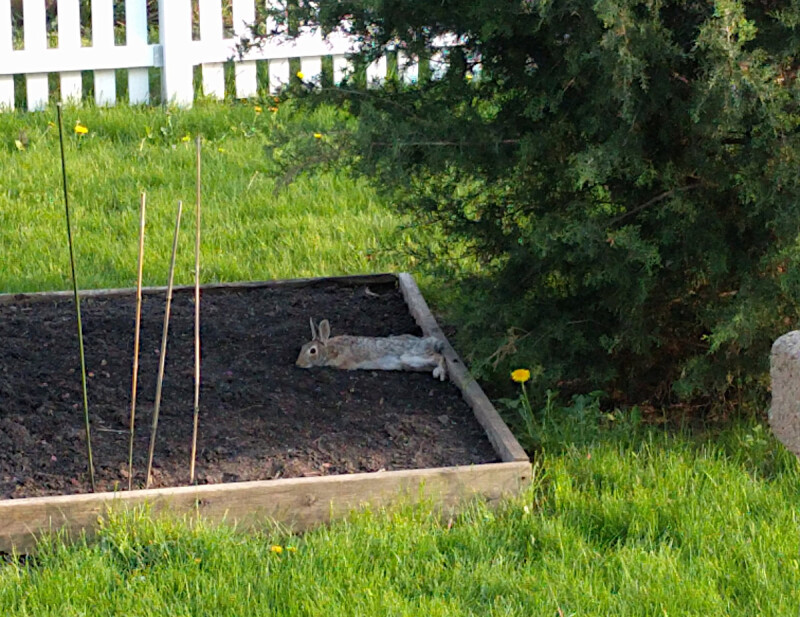
This rabbit prefers we leave the bed unused, thanks.
The circle garden
There was one more feature in the yard that could have been a problem but instead I saw as an opportunity. The previous residents had kept an enormous above-ground pool in the side yard for quite a few years. The pool was gone when we moved in, but in its place was a large circular patch of totally bare dirt. It was a good size for a garden, and planting it with vegetables was going to be a lot more fun than letting the weeds plant it.
I did a halfhearted job of double-digging the circle to loosen up the soil. In the process I discovered that some sections of the space had about 8” of decent soil before hitting a layer of compacted rocks and rubble—this would be a recurring theme in the yard. It quickly became clear that digging into this compacted layer and sifting out the rocks would take far too much time and effort. This was a temporary site, not a permanent one, so it didn’t need to be perfect. I dug down as far as the good soil and left the stuff below it alone.
It was already past planting time, so as soon as it was ready I started putting things in the ground. I had some seeds from previous years, and I bought some starts at the Friends Plant Sale and a couple neighborhood plant sales. I also acquired a few plants from neighbors giving away extras, though one of those I would come to regret.
Planks salvaged from the garage formed makeshift paths, and I got a bale of straw from a garden center for mulch.

Rabbits started snipping things the moment I planted. Luckily I was cruising the free section on Nextdoor pretty heavily around this time and had acquired some chicken wire and t-posts, so that made a makeshift fence. At some point I got some landscape staples and used those to hold down the bottom of the fence, and that arrangement provided sufficient protection throughout the season.
Bonus bed
In addition to the circle garden, the small raised bed was available for use, so I planted it with tomatoes and a few flowers and other leftovers. This bed didn’t have any critter protection, but thankfully the rabbits around here have never shown any interest in tomato plants.

The juniper right next to the bed, however, got in the way of maintenance and harvesting. I never figured out what the logic was in this placement. The boards were also rotting and coming apart, so I didn’t expect this bed to exist beyond this year.
Pretty good results
Given the limited amount of site preparation and the numerous imperfections in my process, I feel like I got as good of results as I could have hoped for. There was remarkably little weed pressure–I think the pool must have been in place for so long that the weed seeds underneath it had rotted or lost viability.
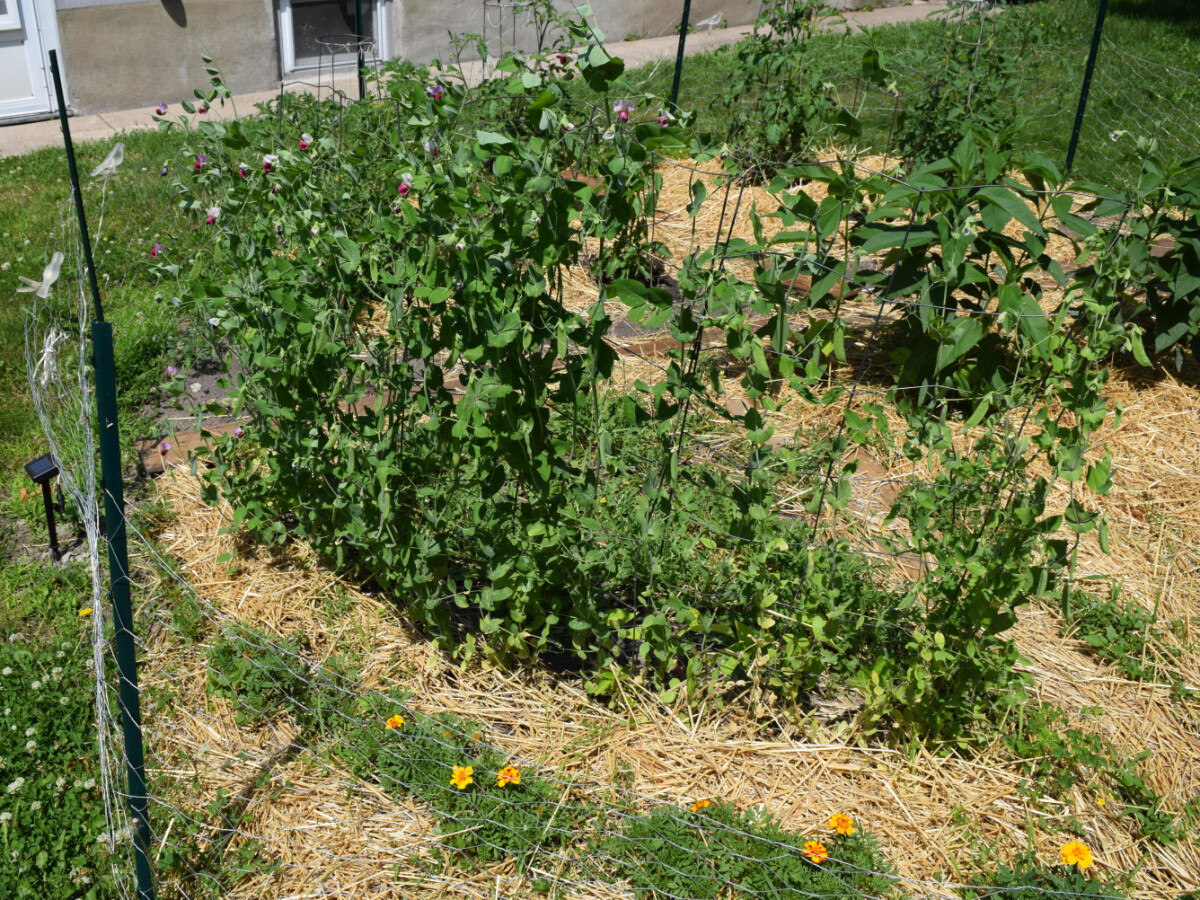
Most of the vegetables grew well, considering the soil hadn’t been amended or improved in any way. I did buy some liquid fertilizer that I applied to the tomatoes and flowers a couple times. It’s from a local company that grinds up invasive carp into a nutrient-rich fish juice. What a great use for an unwanted species! As you might imagine, it smells a bit fishy when applied, but that smell is gone by the next day.
We got a nice crop of tomatoes, which is good because they are a top garden priority around here. The greens were also good, with more arugula than I could harvest and a stellar performance from the “Amish Deer Tongue” lettuce, which has earned itself a permanent place in my planting lineup. Beans and peas are always a good bet, and we had a nice mix of herbs too.
This is not to say there weren’t failures. I planted quite a few herb and flower seeds that never germinated. Many of these were from packets I’d been holding on to for years, so it’s likely a lot of the seeds were just too old. I tried to grow a tomato plant from saved seed, but lacking any way to start it indoors, I just direct-seeded in mid-May and it barely reached maturity before the weather got too cold. We also impulse-purchased some Prairie Smoke plants without any specific plan on what to do with them. Well, those are fairly reticent native perennials that take several years to establish before flowering, so not a great choice for a garden-in-transition.
I also made one more error that seemed small at the time but would come back to haunt me.
The sunchoke mistake
Sunchokes, also known as Jerusalem Artichokes, are a perennial relative of the sunflower with tasty edible tubers. They are also often described as an aggressive spreader, to be treated with care. I took these warnings too lightly and paid for it. When someone on Nextdoor offered free baby sunchokes dug from their yard, I biked over and grabbed a handful of starts, which I plopped in the middle of the circle garden.
Mistake #1: Right in the middle of the garden. My thinking at the time was that they were taller so they could be flanked by shorter plants without blocking views or sun. In retrospect, what I actually did was provide them with a ton of open soil to colonize and no barriers to keep them contained.
Mistake #2: I suspect these sunchokes were a wild type. There are cultivars that produce bigger tubers and spread less vigorously, but these were probably the undomesticated variety. I’ve since reined in my use of free plants from neighbors, in large part because of this sort of loss of control over the finer details of what gets planted.
The sunchokes grew okay through the season, though they “lodged” (i.e. fell over) after enduring some moderate winds. The first disappointment came when I dug them at the end of the season and discovered that they had created almost no edible tubers. Their root systems contained a few tubers too tiny to be practical and a ton of rhizomes (long-distance horizontal roots), and if that sounds like foreshadowing it’s because it is.
The real bad news arrived the following spring (2018), when hundreds of volunteer sunchoke plants appeared all around the circle garden.

I've made a huge mistake.
Not only were there a ton clustered around where I had planted the sunchokes the previous year, but seedlings were also showing up as far as five feet away. Turns out those rhizomes had placed little tubers all over the place, ready to colonize. By this time, I had seeded the circle garden with native plants, and while sunchokes are technically a native, I didn’t want them to dominate this area like they were clearly prepared to do.
How do you fight a sunchoke infestation? It’s not easy, but it’s possible. Mowing is an option, but it would have to be done very regularly to be effective—the sunchokes didn’t mind being cut back and would quickly regrow. Mulching would probably work, but I suspect it would have to be a very impenetrable layer to foil these vigorous plants.
I chose a war of attrition, making frequent patrols throughout the summer to pull up every sunchoke plant I found in the area. More would sprout, and a week later I’d pull them up again. When I had time, I’d also use a trowel to dig out the tubers themselves so they couldn’t just send up a new stem. This strategy did eventually work, but it took a whole summer of regular attention before I got things under control. I probably spent more time on this than on all the other weeding I’ve done in this garden in its whole existence.
Luckily, I didn’t let this ordeal put me off of growing sunchokes, and I have since planted some elsewhere that are now one of my favorite and most productive crops. You should consider growing sunchokes too, but learn from my mistakes: grow a named cultivar, and situate it somewhere that is easy to control the spread.

Me, later, with some better-behaved sunchokes.
Retirement
By the 2018 growing season, I had established a large permanent vegetable garden elsewhere in the yard and no longer needed the circle space for food. So now what?
We didn’t (and still don’t) have a strong vision for this part of the yard. It’s on the side of our house and visible from the kitchen window, so Katherine wants something pretty to look at while she washes dishes. We want a small open area for lounging in the sun, but I had no desire to convert all of it back into grass (I hate grass). We could eventually want to use this space for something specific, like a playhouse, a picnic table, a… dog palace? Something. With the future use a question mark, I didn’t want to plant it up with very permanent stuff like fruit trees.
In the end, I decided to take the path of least resistance. The grass areas around the circle would remain grass for the moment, and I would plant the circle up with something pretty, rabbit-resistant, and low maintenance. A native plant prairie seemed like the perfect choice. It would look nice, it wouldn’t need much care, and since we weren’t using the space for anything else, it would be put to work providing food and habitat for native insects. With the vegetable garden nearby, it would also provide an enticing hangout spot for predator insects who help control pests.
With the native plants in the rain garden, I had taken a focused, careful approach, buying starts and laying them out according to a thoughtful design plan. There was to be none of that here. I’d put down a bunch of seed and whatever grew, grew. There were also a few perennial food plants–rhubarb, green onions, and perennial arugula–that I left in place, figuring they could wait until I had some other permanent place to move them.
I bought a packet of Pollinator Palooza seed mix from Prairie Moon. As recommended, I sowed the seeds in early winter, right as one of our first major snowfalls arrived. Many native seeds need “cold stratification” to break dormancy, so letting them winter in place is the way to achieve that with the least effort.
Spring 2018 was a pretty weird season. The snow and cold hung around a long time, and then the weather turned on a dime to immediately become hot, dry, summer conditions. I suspect this wasn’t helpful to the seeds, who didn’t have a cool moist transition period to germinate and start establishing. The outcome that year did not look very good. Other than some black-eyed susans, very few native plants showed up and I was concerned that the prairie planting had been a failure.
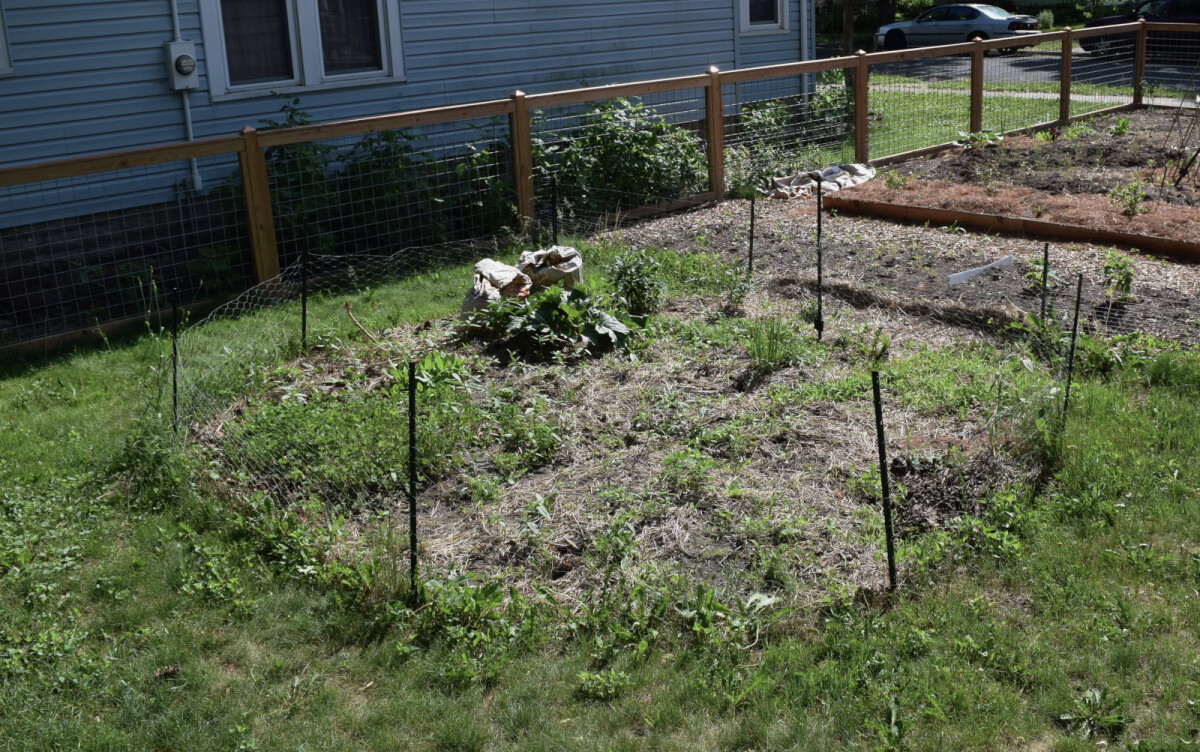
The pocket prairie, year one. Not looking too promising.
Luckily, I didn’t care enough to intervene, and 2019 proved much more successful. Quite a few more natives appeared and the space started to fill in, making the threat of weeds less pressing. We got some nice flowers, not only from the robust and ever-adventurous black-eyed susans, but from some more unusual participants like figwort and native pasture thistle.
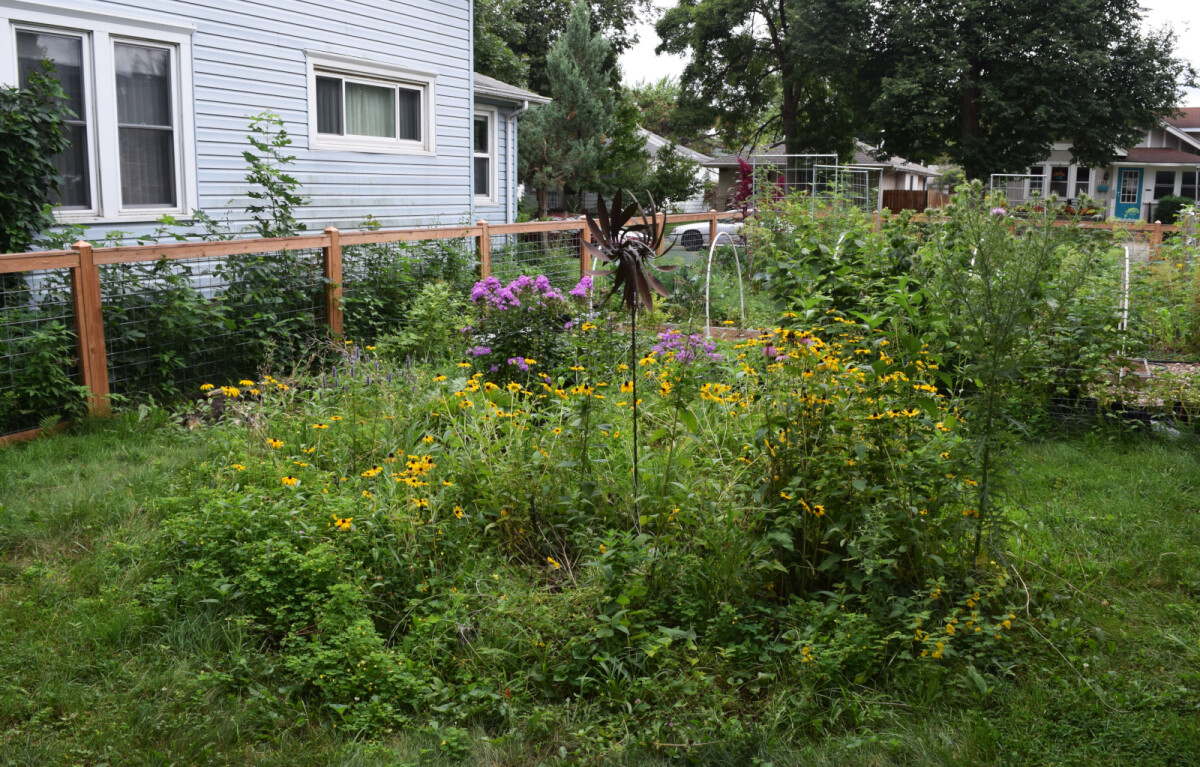
The pocket prairie, year two. Note the black-eyed susans throughout. On the left is some anise hyssop. The big thing on the right is a native thistle. There are a couple purple coneflowers in there too, and some rogue sunchokes that I hadn't pulled yet. In back is some phlox, not native but I got it from a neighbor and left it there until I figured out what to do with it.
The prairie fully arrived in 2020. It’s now a lush area packed with foliage and flowers and constantly busy with pollinators.
I did virtually no weeding or maintenance on it the entire year, and yet almost every plant I could identify was a native. It seems that the natives, now fully established, have thoroughly out-competed the weeds. This was always the plan in theory, but seeing it take place in practice was very exciting.

Looking back, I realized I had put shockingly little work into establishing this area in general. I had done a bit of weeding in the first two years, mostly of pesky sow thistle, but really very little time in the grand scheme of things. The only major time investment was fighting back sunchokes, a problem of my own making. I was probably helped somewhat by not having major weed pressure to begin with, but still, this result feels like a big win.
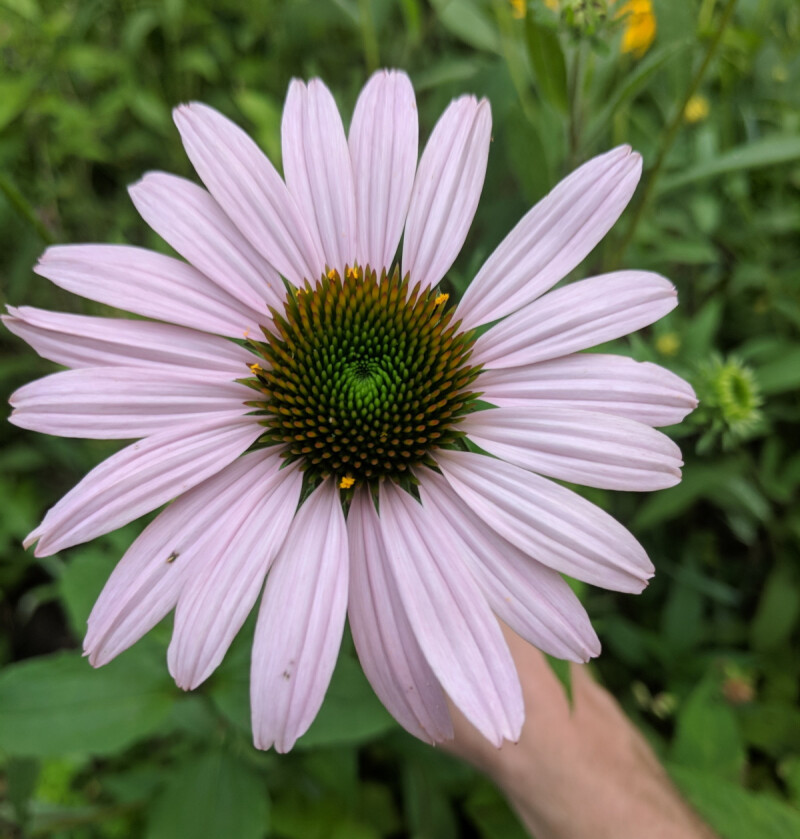
Thirty bucks and some patience got me an area that doesn’t need mowing, looks pretty, and provides a huge boost of biodiversity. The wild and slightly unruly nature of it wouldn’t work in every situation (this year, notably, a gaura grew about 7 feet tall and then epically flopped over), but in this spot it works great. Also, the dog likes to bushwhack through this area for no obvious reason. I swear part of the appeal for her is that if she gets into the middle, the plants are thick enough she’s completely hidden from sight.

Dog approved.
Whirligig
Once a year, Katherine travels to rural Wisconsin to attend a barn dance. On her way there, she passes a garden store that is known in the area for making outstanding whirligigs. Seriously. You probably thought all whirligigs were about the same quality, but that’s just because you’ve never encountered a truly exemplary whirligig before. These ones spin effortlessly and come with a lifetime rebalancing guarantee.
After some discussion, we agreed to invest in a whirligig, so on her next Wisconsin trip Katherine brought one home. We didn’t have a specific spot in mind for it, but we tried it out in the prairie area and thought it fit in very nicely, so it lives there now.
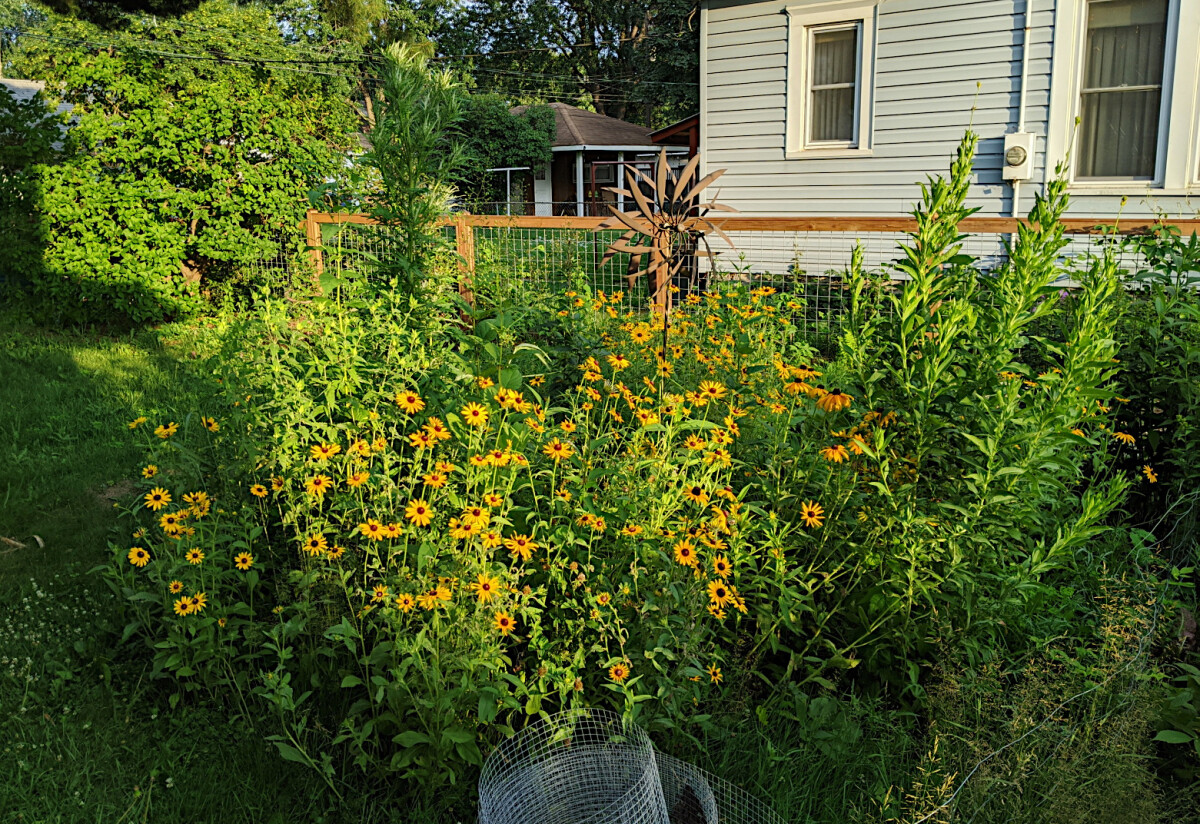
The only issue we have is that suicidal figwort plants keep trying to grow directly into the spinning blades and get all chewed up, so we have to keep trimming them back. We even moved it to a different spot and somehow a new figwort appeared and dove right into the blades.
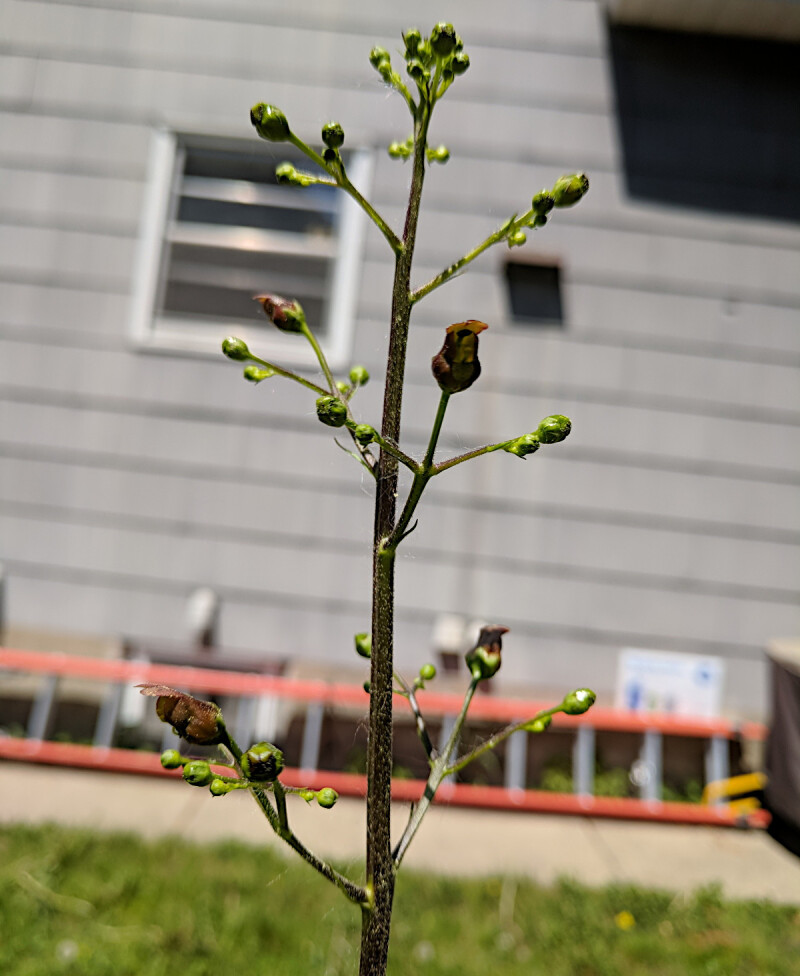
“I crave death!”
Anyhow, it’s a great whirligig.
Plant List (first year)
- Peas, “Dwarf Gray Sugar”
- Arugula “Sylvetta”
- Mesclun Mix
- Lettuce, “Amish Deer Tongue”
- Sunchokes
- Tomato, “Paul Robeson”
- Tomato, “Cherokee Purple”
- Tomato, “Cosmic Eclipse”
- Tomato, “Iglehart Yellow”
- Tomato, “Black Cherry”
- Tomato, “Roma”
- Sweet Pepper, “King of the North”
- Sweet Pepper, “Yellow Monster”
- Pole Bean, “Kentucky Wonder”
- Scallions
- Basil, “Herb Emily”
- Rosemary, “Mozart”
- Dill, “Dukat”
- Dill, “Tetra”
- Cilantro
- Thyme, English
- Peppermint
- Zinnia, “Benary’s Giant Wine”
- Marigolds
- Prairie Smoke
Plant List (wildflowers)
Wildflowers I’ve positively identified from the seed mix:
- Agastache foeniculum (Anise Hyssop)
- Baptisia alba (White Wild Indigo)
- Chamaecrista fasciculata (Partridge Pea)
- Cirsium discolor (Pasture Thistle)
- Coreopsis lanceolata (Lance-leaf Coreopsis)
- Echinacea purpurea (Purple Coneflower)
- Gaura longiflora (Large-flowered Gaura)
- Monarda fistulosa (Wild Bergamot)
- Penstemon digitalis (Foxglove Beardtongue)
- Rudbeckia hirta (Black-eyed Susan)
- Scrophularia lanceolata (Early Figwort)
Time & Materials
| Vegetable garden | ||
|---|---|---|
| Plants | ~$35 | |
| Straw bale | $11 | |
| Cod juice fertilizer | $8 | |
| Chicken wire and t-posts | free | |
| Salvaged planks | free | |
| $54 | ||
| Native prairie | ||
| Pollinator Palooza seed mix | $29 | |
| Whirligig | ~$140 | |
| $170 | ||
| Vegetable garden | ||
|---|---|---|
| Prep | ~4 hours | |
| Planting | ~4 hours | |
| Maintenance | ~1 hour per week | |
| Native prairie | ||
| Seeding | ~1 hour | |
| Sunchoke infestation | ~12 hours | |
| First year (weeding, mowing) | ~6 hours | |
| Second year (weeding) | ~4 hours | |
| Third year (weeding) | ~1 hour | |
